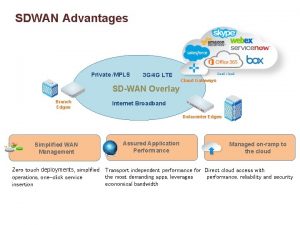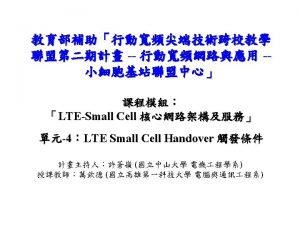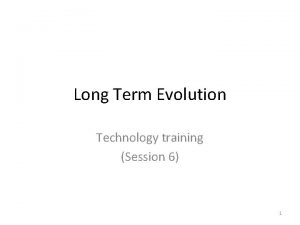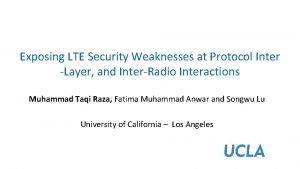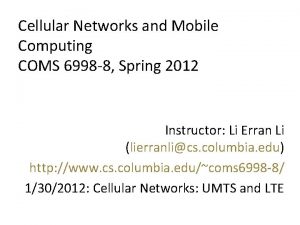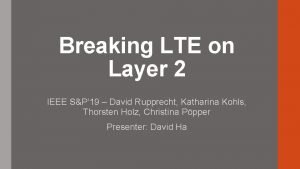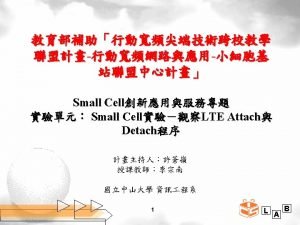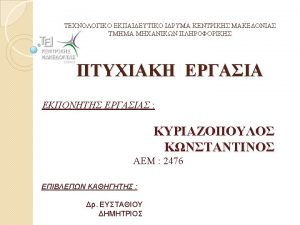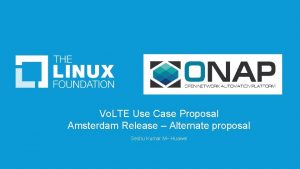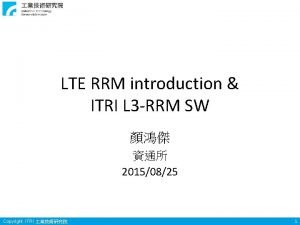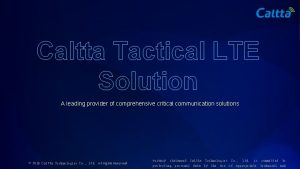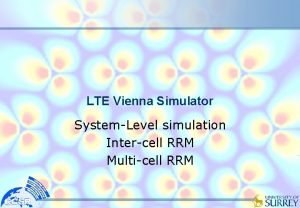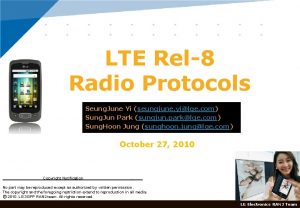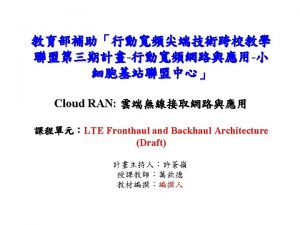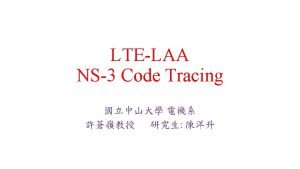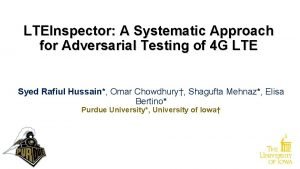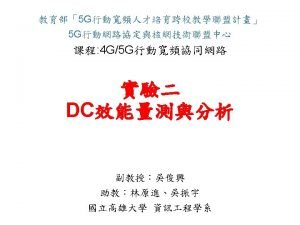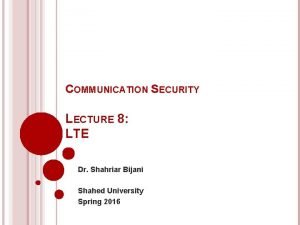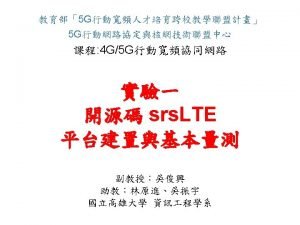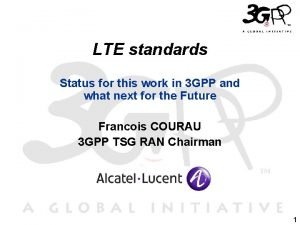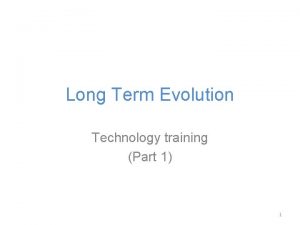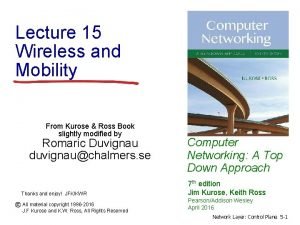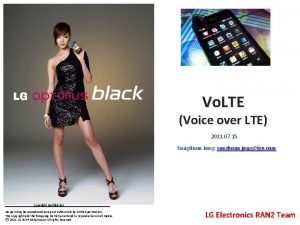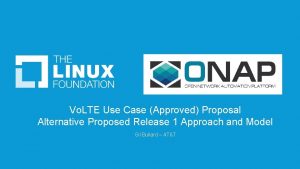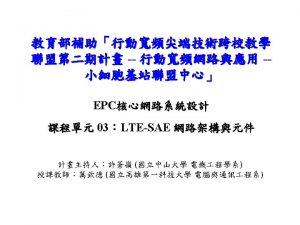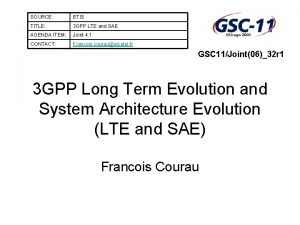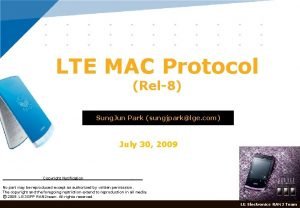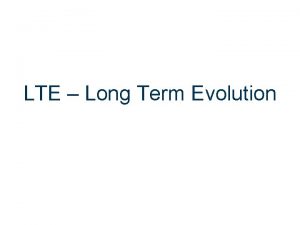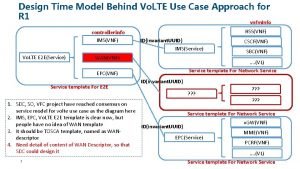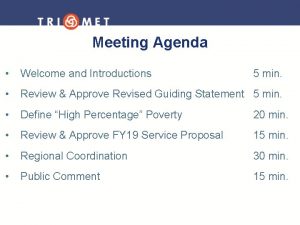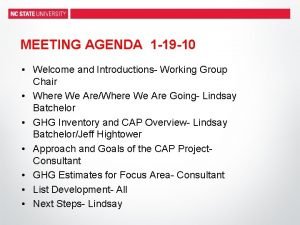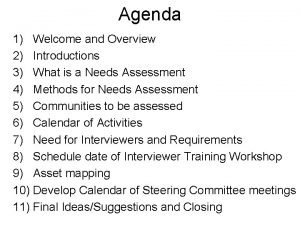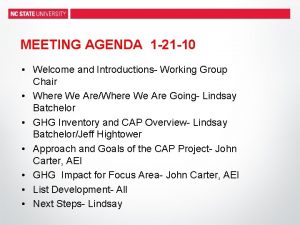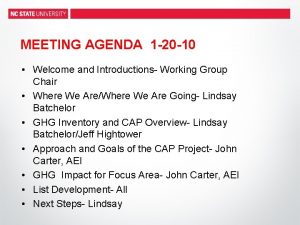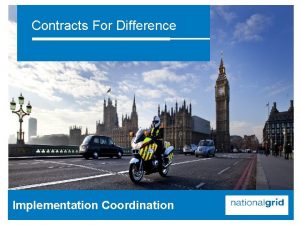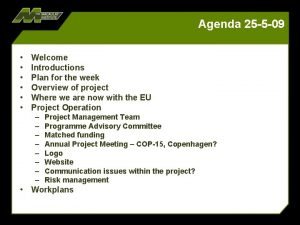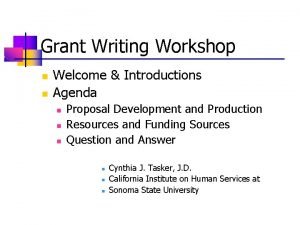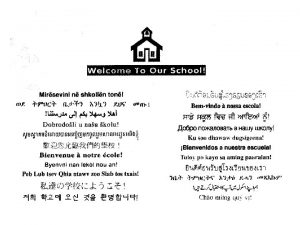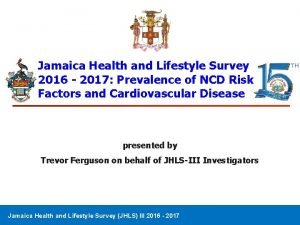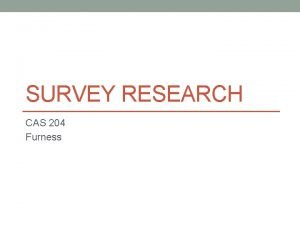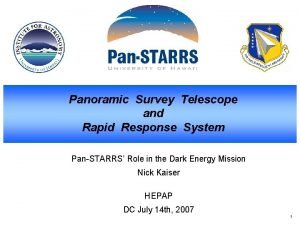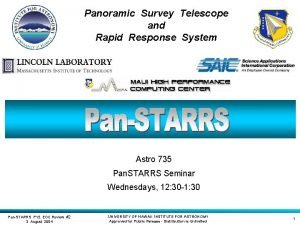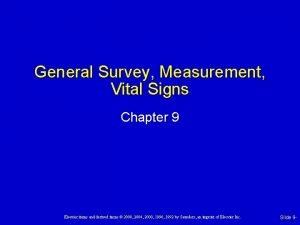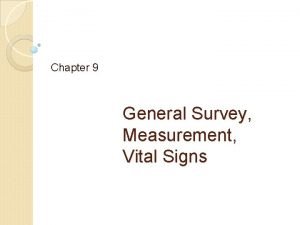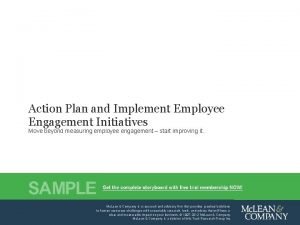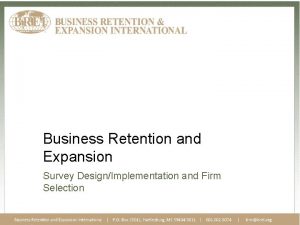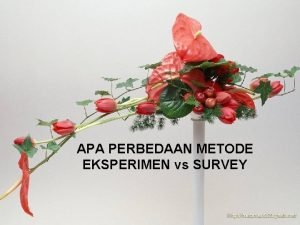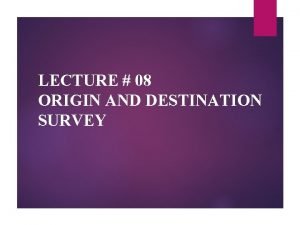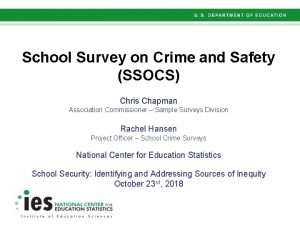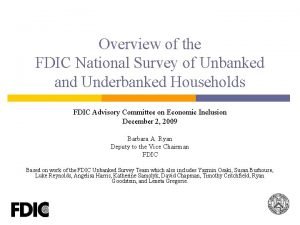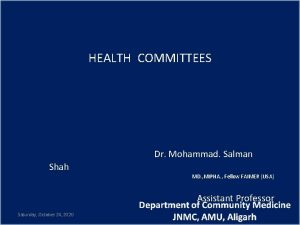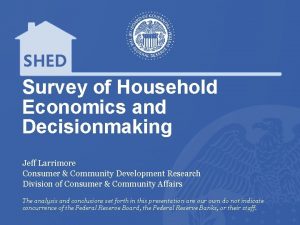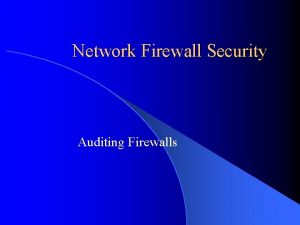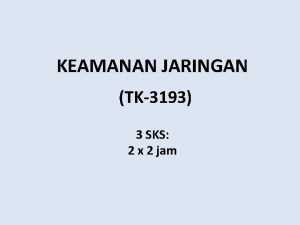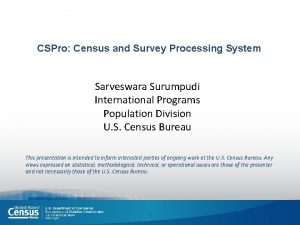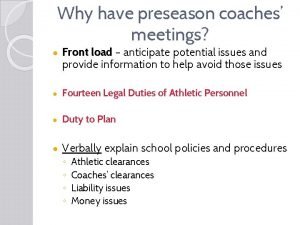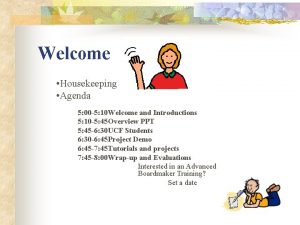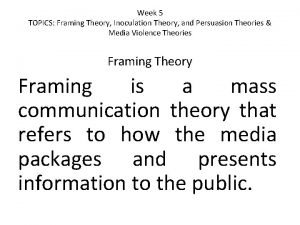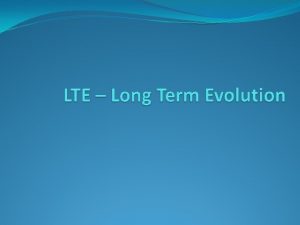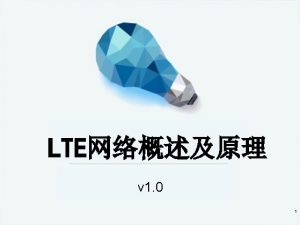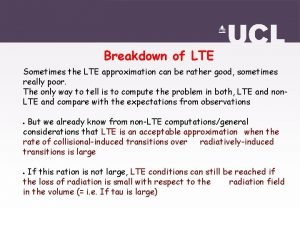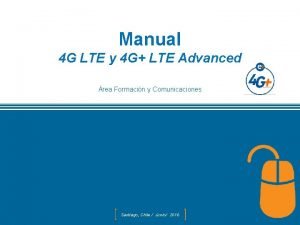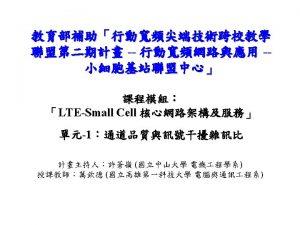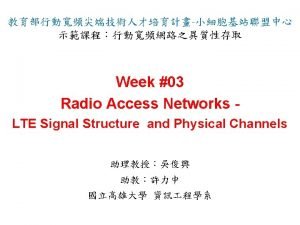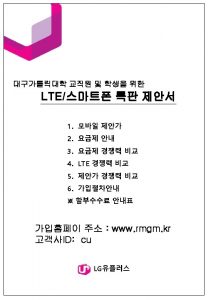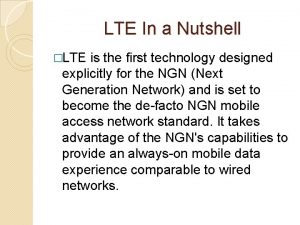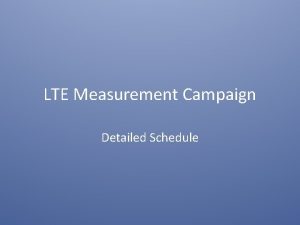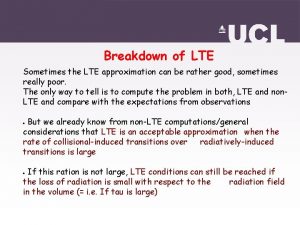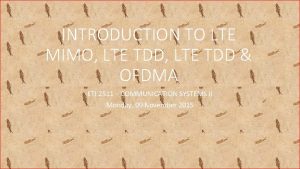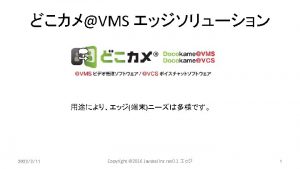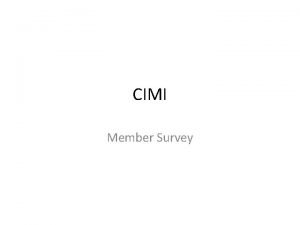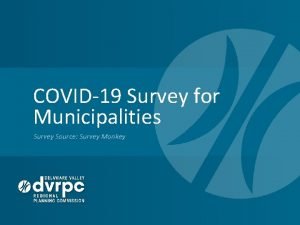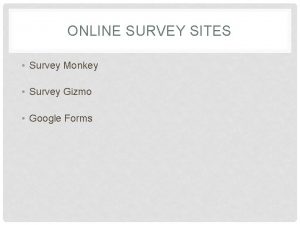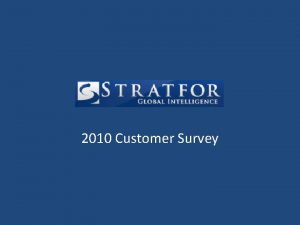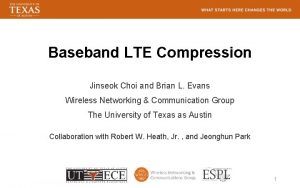Survey of 3 G and LTE Agenda n


















































































- Slides: 82

Survey of 3 G and LTE

Agenda n n n Introduction of Telecommunication Wireless Generation 1 G / 2 G/ 3 G and 4 G GSM Architecture Call Path Mobile to Mobile 3 G Requirement LTE

Introduction of Telecommunication

What is Telecommunication ? n Telecommunication means to change information into electronic signals for remote transmission and switching. n Fast Deployment n Saving Transmission cost. n Easy and Fast Access.

Frequency The frequency of a radio wave is the number of times that the wave oscillates per second. " n q q q n FM Radio : Television : Mobile Networks : 100 MHz Approx. 300 – 2000 MHz Approx. An MS Communicate with a BTS by transmitting and receiving radio waves, which consist of electromagnetic energy.

Bandwidth n n n In electronic communication, bandwidth is the width of the range (or band) of frequencies that an electronic signal uses on a given transmission medium. In this usage, bandwidth is expressed in terms of the difference between the highest-frequency signal component and the lowest-frequency signal component. Bandwidth = Highest freq – Lowest Freq

Channels n A Channel is a frequency or set of frequency which can be allocated for the transmission and reception of information. n Types Of Communication Channels.

GSM Frequency Concepts

What is Multiple Access n Simultaneous private use of a transmission medium by multiple independent users is called Multiple Access. n Advantages Of Multiple Access • • • Increased capacity Reduced capital requirement Decreased per user expense

FDMA, TDMA & CDMA n FDMA (Frequency Division Multiple Access) n Each user on a different frequency A channel is a frequency n n n TDMA (Time Division Multiple Access) Each user on a different window period in time slot. CDMA (Code Division Multiple Access) Each user uses the same frequency all the time but mixed with different distinguished code patterns.

Cellular Generation

Wireless Access Evolution & Background Subscribers § New Services § Efficiency § Voice Quality § Portability § Coverage § Mobility Voice § Capacity § Data Service Broadband § More Data Services required § Broadband § Network Simplification § Cost of Ownership

st 1 Generation Cellular System n Widespread introduction in early 1980 s. n Analogue modulation. FM n Frequency division multiple access. FDMA n Voice traffic only. n No inter-network roaming possible. n Insecure air interface. n Examples : q AMPS (Advance mobile Phone System, American based, 800 MHz) q TACS (Total Access Communications System, UK based, 900 MHz) q C-450 (German standard, 450 MHz) q JTACS (Japanese Total Access Communications System, 900 MHz).

2 nd Generation Cellular System n Widespread introduction in 1990 s. n Use digital modulation. GMSK n Variety of multiple access strategies. n More efficient use of radio spectrum. n International roaming capability. n Secure air interface. n Compatibility with ISDN.

GSM STRUCTURE

GSM Architecture Overview n A GSM system is made up of three subsystems: q q q n The mobile station (MS) The Base station subsystem (BSS) The Network and switching subsystem (NSS) The interfaces defined between each of these sub systems include: q q q “A” interface between NSS and BSS “Abis” interface between BSC and BTS (Within the BSS) “Um” air interface between the BSS and the MS

BASIC GSM BLOCKS BSC MSC/VLR Warid BSC

THE GSM Mobile Station (MS) The Mobile station (MS) consists of the physical equipment used by a a PLMN subscriber to connect to the network. It Comprises q q Mobile Equipment (ME) Subscriber Identity Module (SIM) The SIM stores permanent and Temporary data about the mobile, the subscriber and the network, including q q q International Mobile subscriber Identity (IMSI) MSISDN number of subscriber Authentication key and Algorithms for authentication check.

The Base Station Subsystem (BSS) The Base Station Subsystem is the system of Base station equipments (BTS and BSC), which is viewed by the MSC through a single A-interface n n The BSS Consist of : q One Base station Controller (BSC) q One or more Base Transceiver (BTS) The Purpose of BTS is to : q Provide radio access to the mobile stations q Manage the radio access aspects of the system

Base Station Subsystem n BTS Contains : q Radio Transmitter/Receiver (TRX) q Signal processing and Control equipment q Antennas and Feeder cables n The BSC : q Allocates a channel for the duration of a call q Controls the power transmitted by the BTS or MS q Generates the handover to another cell when required.

Network Switching Subsystem (NSS) Key Elements of NSS: n n Mobile switching center (MSC) with: q Visitor Location Register (VLR) q Home Location Register (HLR) q Authentication center (Au. C) n Equipment Identity Register (EIR) n Gateway MSC (GMSC)

The Mobile Switching Center (MSC) § The Mobile services switching center is an exchange which performs all the switching and signaling functions for mobile stations located in a geographical area designated as the MSC area. n Functions Of MSC: q Switching calls, controlling calls. q Interface with PSTN, ISDN q Mobility management over the radio network and other networks. q Billing information.

The Visitor Location Register (VLR) n Each MSC has a VLR but a VLR may serve many MSCs. n VLR Stores data temporarily for mobiles served by the MSC. n Information stored includes : q IMSI q MSISDN q MSRN q TMSI q LAI q Supplementary service parameters.

Home Location Register (HLR) § HLR stores details of all subscribers in the network, such as: n q Subscription information q Location information : MS roaming number, VLR, MSC. q MS ISDN number. q Service restrictions. q Supplementary services. Together with the Au. C, HLR checks the validity and service profile of subscribers.


Call Path Mobile to Mobile

BSC VMS HLR EIR Voicemail Pre. Paid SMSC PSTN Fixed Network OMO

BSC VMS HLR EIR Voicemail Pre. Paid SMSC PSTN Fixed Network OMO

BSC VMS HLR EIR Voicemail Pre. Paid PSTN Fixed Network MSC OMO SMSC

BSC VMS HLR EIR Voicemail Pre. Paid PSTN Fixed Network MSC OMO SMSC

BSC Base Station Controller n n The call request reaches the BSC from the BTS and is forwarded to MSC. After call is established, the BSC will perform decoding of the call (in typical config. )

BSC VMS HLR EIR Voicemail Pre. Paid PSTN Fixed Network MSC OMO SMSC

BSC VMS HLR EIR Voicemail Pre. Paid PSTN Fixed Network MSC OMO SMSC

n n n Checks A number. To whom is A subscriber calling? (Checks B number) Example : A subscriber has prepaid number. MSC Mobile Switching Centre

BSC VMS HLR EIR Voicemail Pre. Paid PSTN Fixed Network MSC OMO SMSC

BSC VMS HLR EIR Voicemail Pre. Paid PSTN Fixed Network MSC OMO SMSC

BSC VMS HLR EIR Voicemail Pre. Paid PSTN Fixed Network MSC OMO SMSC

n n Does the A subscriber have money left on his/her account? When the call is established and on-going the subscriber’s account is decremented accordingly. Pre. Paid Node

HLR BSC VMS EIR Voicemail Pre. Paid PSTN Fixed Network MSC OMO SMSC

HLR BSC VMS EIR Voicemail Pre. Paid PSTN Fixed Network MSC OMO SMSC

HLR BSC VMS EIR Voicemail Pre. Paid PSTN Fixed Network MSC OMO SMSC

n n Where is the B subscriber? MSC interrogates in HLR. (HLR = Home Location Register) MSC Mobile Switching Centre

HLR BSC VMS EIR Voicemail Pre. Paid PSTN Fixed Network MSC OMO SMSC

HLR BSC VMS EIR Voicemail Pre. Paid PSTN Fixed Network MSC OMO SMSC

HLR BSC VMS EIR Voicemail Pre. Paid PSTN Fixed Network MSC OMO SMSC

n n HLR says ’I am the home of the B subscriber and I know where he/she is right now’ (i. e. which VLR) Tells this VLR ’Give me a visitor address for this subscriber’ (Roaming Number) HLR Home Location Register

HLR BSC VMS EIR Voicemail Pre. Paid PSTN Fixed Network MSC OMO SMSC

HLR BSC VMS EIR Voicemail Pre. Paid PSTN Fixed Network MSC OMO SMSC

HLR BSC VMS EIR Voicemail Pre. Paid PSTN Fixed Network MSC OMO SMSC

n Hosting MSC/VLR returns TEMPORARILY assigned visitor/roaming address for Bsubscriber to HLR. MSC Mobile Switching Centre

HLR BSC VMS EIR Voicemail Pre. Paid PSTN Fixed Network MSC OMO SMSC

HLR BSC VMS EIR Voicemail Pre. Paid PSTN Fixed Network MSC OMO SMSC

HLR BSC VMS EIR Voicemail Pre. Paid PSTN Fixed Network MSC OMO SMSC

n n ’Thanks for the visitor address!’ ’I will send this address to the MSC that requested for it. ’ HLR Home Location Register

HLR BSC VMS EIR Voicemail Pre. Paid PSTN Fixed Network MSC OMO SMSC

HLR BSC VMS EIR Voicemail Pre. Paid PSTN Fixed Network MSC OMO SMSC

HLR BSC VMS EIR Voicemail Pre. Paid PSTN Fixed Network MSC OMO SMSC

HLR BSC VMS EIR Voicemail Pre. Paid PSTN Fixed Network MSC OMO SMSC

n n BSC now sends a PAGING MESSAGE to all the BTSs that it covers/controls. Carrys PAGING RESPONSE from called MS back to MSC. Allocates a RADIO channel through a BTS with best available and allowable SIGNAL STRENGTH for called MS. Performs SPEECH CODING when call is established. BSC Base Station Controller

HLR BSC VMS EIR Voicemail Pre. Paid PSTN Fixed Network MSC OMO SMSC

HLR BSC VMS EIR Voicemail Pre. Paid PSTN Fixed Network MSC OMO SMSC

GSM to 3 G Steps

Why we need 3 G? Or 3 G is enough for us?

Secretes of Upgrades n Maximize----Spectrum Efficiency FDMA/TDMA/CDMA/OFDMA Power Efficiency-------Battery n Minimize ----Complexity ----Cost

3 G Release Timeline HSDPA WCDMA HSUPA HSPA+ LTE MSC Split Rel 8 Rel 99 Rel 4 1999 2000 Rel 5 2001 2002 Rel 6 2003 2004 2005 Rel 7 2006 2007 2008

Migration Stages

3 G Requirement n. New Services n. Efficiency n. More Data Services required

Steps towards 3 G 1 - Backbone Roll Out (Packet Network) All the backend traffic transfer on IP (Packets) /Passport/ATM/MPBN 2 - Data Network 3 - Core Network 4 - RAN Network

1 -Backbone Roll Out (Packet Network)

2 -Data Network Migration

3 -Core Network Migration Classical MSC Architecture (old name: Non-Layered Mobile Core Network/ ’Monolitic’ Architecture) MSC Server Classic MSC Mobile Softswitch Solution (old name: Layered Mobile Core Network Architecture) (Control and Switching) MSC-S (Control) Mobile Media Gateway MGw (Switching) Control Layer MSC-S MSC MGw TDM MSC MSC MGw IP/ATM/TDM MGw MGw

2 G Towards 3 G Networks IP networks Only PS Domain shown Gi HLR PCRF Gr Gn Gx Gn GGSN SGSN Gb Iu • Policy Control and Charging Rules Function (PCRF) - to manage Quality of Service (Qo. S) aspects BSC RNC BTS Node B 2 G 3 G Iur

HSPA (Higher Speed Packet Access) IP networks Only PS Domain shown Gi HLR/HSS PCRF Gr Gx Gn GGSN SGSN Gb Iu CP Iu UP BSC RNC BTS Node B 2 G Optimizing the 3 G/HSPA payload plane for Broadband traffic 3 G Iur 10 Mb/s

Requirement of LTE n. Broadband n. Network n. Cost Simplification of Ownership

LTE (Long Term Evolution) n LTE focus is on: q enhancement of the Universal Terrestrial Radio Access (UTRA) q optimisation of the UTRAN architecture n With HSPA (downlink and uplink), UTRA will remain highly competitive for several years n LTE project aims to ensure the continued competitiveness of the 3 GPP technologies for the future

LTE Requirements (1) n Reduced cost per bit q q Improve spectrum efficiency ( e. g. 2 -4 x Rel 6) Reduce cost of backhaul (transmission in UTRAN) n Increased service provisioning – more services at lower cost with better user experience n n Focus on delivery of services utilising ”IP” Reduce setup time and round trip time Increase the support of Qo. S for the various types of services (e. g. Voice over IP) Increase “cell edge bit rate” whilst maintaining same site locations as deployed today Increase peak bit rate (e. g. above 100 Mbps DL and above 50 Mbps UL) Enhance the bit rate for MBMS (e. g. 1 -3 Mbps) n Allow for reasonable terminal power consumption n n

LTE Requirements (2) n n Flexibility of use of existing and new frequency bands Allow to deploy in wider and smaller bandwidths than 5 MHz ( e. g. ranging from 1. 25 to 20 MHz) n Allow variable duplex technology within bands as well as between bands n Non-contiguous spectrum allocations to one UE should not be precluded

LTE Architecture PA/DU Core & IMS IP networks SGi HLR/HSS ”HLR/HSS” Gr PCRF S 6 a S 4 SGSN MME S 3 S 11 ”Mobility Server”S 10 Gb Iu CP PDN GW Serving GW BTS 2 G S 2 a/b ”Gateway” Iu UP S 1 -MME BSC S 7 EPC RNC Iur S 1 -U RBS e. Node. BB e. Node PA/DU Radio X 2 Node B 3 G LTE OSS Non-3 GPP access

Mobile broadband speed evolution LTE Evolution LTE HSPA Evolution HSPA 3 G- R’ 99 Peak rate 384 kbps 2002 3. 6 Mbps 2005 7/14 Mbps 2007 21/28/42 Mbps ~150 Mbps Target 1 Gbps 2008/2009 2013

ABBREVIATIONS n n n MSC – Mobile Switching center BSC – Base station controller BTS – Base Transceiver station TRX – Transceiver MS - Mobile Station OMC – Operation and Maintenance Center PSTN – Public Switched Telephone Network BSS – Base Station Subsystem HLR – Home Location Register VLR – Visitor Location Register Au. C – Authentication Center EIR – Equipment Identity Register

References n n http: //www. 3 gpp. org/ http: //www. radio-electronics. com http: //www. ericsson. com/technology/whitepa pers/lte_overview. pdf http: //www. ngmn. org/

Thank you
 Agenda sistemica y agenda institucional
Agenda sistemica y agenda institucional 叫叫abcde
叫叫abcde Mpls over lte
Mpls over lte Lte handover events
Lte handover events Transmit diversity in lte
Transmit diversity in lte Paging in lte
Paging in lte Frame structure in lte
Frame structure in lte Lte layer 2
Lte layer 2 Gpp network
Gpp network Lte τεστ προσομοιωσης
Lte τεστ προσομοιωσης V0 lte
V0 lte L
L Tactical lte
Tactical lte Congress of vienna simulation
Congress of vienna simulation Lte nas procedures
Lte nas procedures C-ran
C-ran Lte full duplex
Lte full duplex Lteinspecteur
Lteinspecteur V lte symbol on phone
V lte symbol on phone Gpp lte means
Gpp lte means 172 0 0 1
172 0 0 1 Gpp lte meaning
Gpp lte meaning Physical layer in lte
Physical layer in lte Lte network architecture
Lte network architecture V0 lte
V0 lte Lte vo
Lte vo Sae epc
Sae epc Gpp lte
Gpp lte Dtch lte
Dtch lte Dtch lte
Dtch lte V0 lte
V0 lte Meet and greet agenda
Meet and greet agenda Agenda welcome and introductions
Agenda welcome and introductions Meeting agenda welcome and introductions
Meeting agenda welcome and introductions Agenda welcome and introductions
Agenda welcome and introductions Agenda welcome and introductions
Agenda welcome and introductions Agenda welcome and introductions
Agenda welcome and introductions Agenda welcome and introductions
Agenda welcome and introductions Global agenda for social work and social development
Global agenda for social work and social development Agenda 21 and 30
Agenda 21 and 30 Meeting agenda welcome and introductions
Meeting agenda welcome and introductions Agenda welcome and introductions
Agenda welcome and introductions Agenda web definite and indefinite article
Agenda web definite and indefinite article Agenda welcome and introductions
Agenda welcome and introductions The mass media and the political agenda
The mass media and the political agenda Agenda for parent orientation
Agenda for parent orientation Agenda welcome and introductions
Agenda welcome and introductions Agenda welcome and introductions
Agenda welcome and introductions Double barreled question example
Double barreled question example Security survey is also known as.
Security survey is also known as. General surveying services
General surveying services Jamaica health and lifestyle survey 2019
Jamaica health and lifestyle survey 2019 Survey research advantages and disadvantages
Survey research advantages and disadvantages Objective of sampling
Objective of sampling Panoramic survey telescope and rapid response system
Panoramic survey telescope and rapid response system Panoramic survey telescope and rapid response system
Panoramic survey telescope and rapid response system Lunch and learn survey questions
Lunch and learn survey questions Measurement elsevier
Measurement elsevier Chapter 9 general survey and measurement
Chapter 9 general survey and measurement Cardinal survey and design
Cardinal survey and design Mega city definition ap human geography
Mega city definition ap human geography Action planning for employee engagement
Action planning for employee engagement Scottish survey of literacy and numeracy
Scottish survey of literacy and numeracy Business retention and expansion survey
Business retention and expansion survey Perbedaan penelitian eksperimen dan survey
Perbedaan penelitian eksperimen dan survey Survey and mapping division
Survey and mapping division What is origin destination survey
What is origin destination survey Diff between prismatic and surveyor compass
Diff between prismatic and surveyor compass Dei pulse
Dei pulse Employee engagement action plan presentation
Employee engagement action plan presentation School survey on crime and safety
School survey on crime and safety National survey of unbanked and underbanked households
National survey of unbanked and underbanked households Mipha full form in medical
Mipha full form in medical Survey of household economics and decisionmaking
Survey of household economics and decisionmaking Auditing firewall security
Auditing firewall security Cipd learning and development survey
Cipd learning and development survey Csi computer crime and security survey
Csi computer crime and security survey Census and survey processing system
Census and survey processing system Cahps clinician and group survey
Cahps clinician and group survey Preseason coaches meeting agenda
Preseason coaches meeting agenda Housekeeping agenda
Housekeeping agenda Inoculation marketing
Inoculation marketing Football coaches meeting agenda
Football coaches meeting agenda


